Click on images to enlarge

dense infestation (Photo: Sheldon Navie)
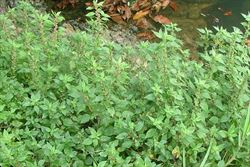
habit (Photo: Sheldon Navie)
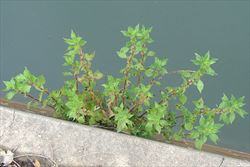
habit growing on a wall (Photo: Sheldon Navie)

leaves (Photo: Sheldon Navie)
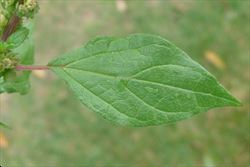
close-up of leaf (Photo: Sheldon Navie)
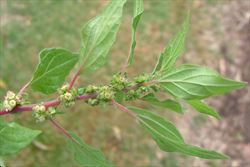
leaf undersides and flower clusters (Photo: Sheldon Navie)

close-up of reddish-coloured stem and flowers (Photo: Sheldon Navie)

close-up of tiny flowers (Photo: Greg Jordan)

close-up of mature fruit (Photo: Sheldon Navie)
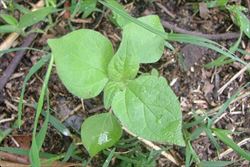
seedling (Photo: Sheldon Navie)
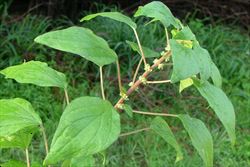
native pellitory, Parietaria debilis (Photo: Sheldon Navie)
Scientific Name
Parietaria judaica L.
Synonyms
Parietaria diffusa Mert. & Koch
Family
Urticaceae
Common Names
asthma weed, dead nettle, Kirribilli curse, pellitory, pellitory of the wall, pellitory-of-the-wall, spreading pellitory, sticky weed, wall pellitory
Origin
This species is native to northern Africa (i.e. Algeria, Egypt, Libya, Morocco and Tunisia), the Azores, the Madeira Islands, the Canary Islands, western and southern Europe (i.e. Belgium, France, Portugal, Spain, Albania, Bulgaria, Greece, Italy, Romania and Yugoslavia, western Asia and the Indian Sub-continent (i.e. northern India, Nepal and Pakistan).
Naturalised Distribution
Widely naturalised in south-eastern Australia, particularly near urban areas. It is common in some parts of eastern New South Wales, southern Victoria and south-eastern South Australia. It is also occasionally naturalised in the coastal districts of south-western Western Australia and in other parts of southern South Australia. In addition, it is naturalised on Lord Howe Island and sparingly naturalised in Tasmania and south-eastern Queensland.
Also naturalised in large parts of North America.
Habitat
A weed of temperate and sub-tropical regions that is often found growing in urban areas (i.e. in walls, footpaths, embankments, etc.). It also inhabits gardens, rocky crevices, cliffs, coastal environs, riparian vegetation, waste areas and roadsides.
Habit
An upright (i.e. erect) or spreading (i.e. decumbent or ascending) and long-lived (i.e. perennial) herbaceous plant usually growing 20-60 cm tall, but occasionally reaching up to 1 m in height.
Distinguishing Features
- an upright or spreading herbaceous plant with four-angled stems that are greenish-brown or reddish-brown in colour.
- its stems and leaves are covered in irregularly curled hairs that feel sticky to the touch.
- its alternately arranged leaves have glossy upper surfaces.
- its inconspicuous flowers are borne in small dense clusters in the leaf forks.
- these greenish flowers often turn reddish or reddish-brown in colour as they mature.
Stems and Leaves
The stems are often much-branched, are greenish-brown or reddish-brown in colour, and are covered in irregularly curled (i.e. crisped) hairs. They are soft and somewhat four-angled (i.e. quadrangular) when young, but can become woody with age.
The alternately arranged leaves are simple, entire, and have somewhat glossy upper surfaces. These leaves (10-80 mm long and 5-30 mm wide) are borne on short stalks (i.e. petioles) 5-20 mm long and are narrowly egg-shaped in outline (i.e. lanceolate-ovate) to oval (i.e. elliptic) in shape. They taper to a point at their tips (i.e. have acute apices) and are also covered in irregularly curled (i.e. crisped) hairs, especially along the veins on their undersides.
Flowers and Fruit
The inconspicuous flowers are borne in small, dense clusters in the leaf forks (i.e. axils). They are initially greenish in colour, but often turn reddish or reddish-brown as they mature. Male, female (i.e. unisexual) and bisexual flowers are borne in separate clusters on each plant, but bisexual flowers are much more numerous. Flowering occurs mostly from spring through until late summer (sometimes throughout the year in warmer areas).
The small hard 'seeds' (i.e. nutlets or achenes) remain enclosed in the persistent flower parts (i.e. perianth segments). They are dark brown to black in colour (1-2 mm long and 0.8-1 mm wide) and either irregularly shaped or somewhat egg-shaped (i.e. ovoid).
Reproduction and Dispersal
This species usually reproduces via seed, but may also reproduce vegetatively via severed root segments.
Seeds are dispersed by wind, water and animals, while both seeds and root segments may be spread in contaminated soil and dumped garden waste.
Environmental Impact
Pellitory (Parietaria judaica) is regarded as an environmental weed in Victoria, New South Wales, South Australia and Western Australia. It was also recently listed as a priority environmental weed in at least one Natural Resource Management region.
Legislation
This species is declared under legislation in the following states and territories:
- New South Wales: Class 4 - a locally controlled weed. The growth and spread of this species must be controlled according to the measures specified in a management plan published by the local control authority and the plant may not be sold, propagated or knowingly distributed (in a large number of local authority areas). See the New South Wales Department of Primary Industries Noxious Weeds List at http://www.dpi.nsw.gov.au for more detailed information on which local areas are covered in these declarations.
- Western Australia: Unassessed - this species is declared in other states or territories and is prohibited until assessed via a weed risk assessment (throughout the entire state).
Management
For information on the management of this species see the following resources:
- the Campbelltown City Council Noxious Weeds Profile Sheet on this species, which is available online at http://www.campbelltown.nsw.gov.au.
- the Ku-ring-gai Council fact sheet on this species, which is available online at http://www.kmc.nsw.gov.au.
Similar Species
Pellitory (Parietaria judaica) is very similar to native pellitory (Parietaria debilis) and shade nettle (Australina pusilla). These species can be distinguished by the following differences:
- pellitory (Parietaria judaica) is a long-lived (i.e. perennial) plant with wiry stems that become slightly woody with age. Its leaves are mostly entire and are borne on relatively short stalks (i.e. petioles) 5-20 mm long.
- native pellitory (Parietaria debilis) is a short-lived (i.e. annual) plant with soft stems. Its leaves are mostly entire and are borne on relatively long stalks (10-30 mm long).
- shade nettle (Australina pusilla) is a long-lived (i.e. perennial) plant with leaves that are usually bluntly toothed (i.e. crenate).

